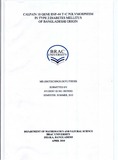| dc.contributor.advisor | Choudhury, Naiyyum | |
| dc.contributor.advisor | Ali, Liaquat | |
| dc.contributor.author | Mir, Salma | |
| dc.date.accessioned | 2012-03-01T07:09:58Z | |
| dc.date.available | 2012-03-01T07:09:58Z | |
| dc.date.copyright | 2010 | |
| dc.date.issued | 2010-03 | |
| dc.identifier.other | ID 08376002 | |
| dc.identifier.uri | http://hdl.handle.net/10361/1627 | |
| dc.description | This thesis report is submitted in partial fulfillment of the requirement for the degree of Masters of Science in Biotechnology, 2010 | |
| dc.description | Cataloged from PDF version of thesis report. | |
| dc.description | Includes bibliographical references (page 63-76). | |
| dc.description.abstract | Insulin resistance and/or B cell secretory defect have been accepted as the fundamental
features in the pathogenesis of type 2 diabetes mellitus, though the exact molecular
defect affecting the insulin secretion or sensitivity still to be clearly elucidated. The
present study was undertaken to determine CAPN 10 gene SNP-44 T>C polymorphism
in Bangladesh type 2 diabetes mellitus and explore its relationship with its insulin
secretory capacity and insulin sensitivity. A total number of 65 T2DM subjects were
recruited and 91 subjects served as control. Glucose was measured by glucose-oxidase, lipids by enzymatic-colorimatric, insulin by ELISA methods. Homeostatic model
assessment was used to calculate pancreatic B cell secretion, expressed on HOMA%B
and insulin sensitivity, 1-IOMA%S. DNA was extracted using QIAGEN spin column
blood DNA kit. CAPN 10 gene polymorphic marker was determined by mutation
specific PCR. Data were managed by statistical package for social science (SPSS). P<0.5 was taken as level significance. T2DM and Control subjects were age and BMI matched. Fasting serum insulin (μU/ml, mean±SD) in the T2DM subjects was significantly higher compared to controls (7.97±3.83 vs 5.01±0.57). Insulin secretory capacity (HOMA%B) in the T2DM group and the controls did not show any significant difference (p=0.240). Insulin sensitivity (I-IOMA%S) was significantly lower in the T2DM group compared to the controls (48.9±21.7 vs 79.9±20.5) (p<0.001). CAPNIO gene SNP-44 genotype frequencies for the T2DM were 0.662, 0.323 and 0.150 for Wild, Ht and Hz variant respectively and in the controls the frequencies were 0.670, 0.297 and 0.330 respectively, which did not show any significant association with diabetes mellitus. Subjects with variant (TC and TT) genotype did not show significant difference regarding glucose, BMI, HOMA%B, HOMA%S either in the T2DM or control group. In conclusion (i) CAPN 10 SNP 44 T>C polymorphism was not associated with T2DM of Bangladeshi origin. (ii) Insulin sensitivity appeared to be predominant in the subsets of T2DM subjects, and (iii) CAPN 10 SNP 44 T>C variant did not show any relation with
pancreatic B cell secretion and insulin sensitivity of the study subjects. | en_US |
| dc.description.statementofresponsibility | Salma Mir | |
| dc.format.extent | 76 pages | |
| dc.language.iso | en | en_US |
| dc.publisher | BRAC University | en_US |
| dc.rights | BRAC University thesis are protected by copyright. They may be viewed from this source for any purpose, but reproduction or distribution in any format is prohibited without written permission. | |
| dc.subject | Biotechnology | |
| dc.title | Calpain 10 gene SNP-44 T>C polymorphism in type 2 diabetes mellitus of Bangladeshi origin | en_US |
| dc.type | Thesis | en_US |
| dc.contributor.department | Department of Mathematical and Natural Science, BRAC University | |
| dc.description.degree | M. Biotechnology | |

